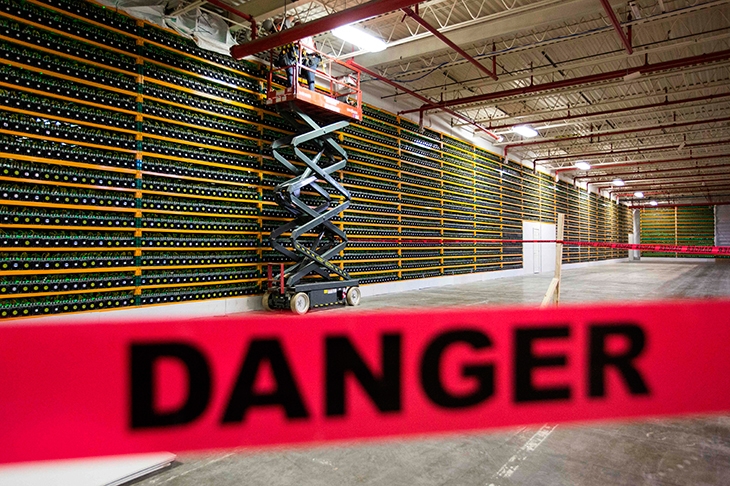‘So, Professor Shin, tell us what you really think about cryptocurrencies.’ I’m guessing that’s the brief the Bank for International Settlements (the Basel-based central bank of central banks) gave economist Hyun-Song Shin to write a chapter for its annual report, published this week. His response delivers a serious kicking to the whole befuddled concept of ‘permissionless’ online currencies that ‘promise to replace trust in long-standing institutions such as commercial and central banks’.
For a start, he argues, Bitcoin and its ilk are an environmental disaster because their systems consume enough electricity to power Switzerland. More importantly, their potential to replace state-backed money, is limited by three factors: scale (crypto computing could not possibly cope with the volume of transactions in a real economy), wild instability (whereas central banks can usually stabilise the value of state money by ‘elasticising’ supply) and a ‘fragile foundation of trust’ (the finality of crypto payments is unguaranteed, and there’s a lot of weird stuff going on out there).
Shin’s short paper is as clear an analysis of the crypto menace as you’ll find. It also nails the point that the blockchain or ‘distributed ledger’ technology which facilitates crypto transactions may well turn out to be the payment system of the future, but that doesn’t mean currencies managed by central banks have somehow become outdated or unsound. It just means something useful might one day emerge as the by-product of a craze that’s partly driven by speculative greed and partly by dopesmoker-libertarian contempt for the state — and is almost certainly riddled with fraud. My view remains that no sensible citizen should dabble in this dark arena, and I sense Professor Shin agrees with me.
Horlicks to the rescue
Whatever happened to Horlicks? Patented in Chicago in 1883 by British-born brothers William and James Horlick, the malted milk drink was manufactured in Slough from 1908 and came to be thought of as a British product — but disappeared from most of our kitchens half a century ago. It lingered only as a figure of speech, as in foreign secretary Jack Straw’s 2003 description of Downing Street’s dossier on Iraqi weapons of mass destruction as ‘a complete Horlicks’. Meanwhile the product itself found a huge market elsewhere — in India, where it had first arrived in British troop rations during the war.
Under the ownership of Beecham, now part of GlaxoSmithKline, Horlicks became one of India’s most popular beverages, especially for children. But having closed the Slough factory last year, GSK has put the brand itself up for sale to raise cash for its £9 billion buyout of a minority stake held by Novartis in a healthcare products joint venture. Coca-Cola, Kraft Heinz and Nestlé have been named as potential buyers of Horlicks; £3 billion is evidently a price worth paying for a foothold in the high-growth Indian marketplace.
If Horlicks is passing out of UK ownership, then at least the repositioning enables GSK, our biggest pharma group, to play to other strengths. But the story is also a reminder that one of our few non-EU overseas trade advantages is India’s love of retro British brands. Let’s face it, we’ll always struggle to compete in global technology; but in unperished 1950s consumer goods, we still have markets to conquer.
Audit warning
Arthur Andersen, formerly one of the world’s ‘big five’ accountancy practices, was so tainted by its role as auditor to the fraudulent Enron Corporation that it went out of business even though the US Supreme Court eventually reversed a criminal conviction against the firm for obstruction of justice. That was the sharpest possible reminder to the audit profession — habitually inclined, we may suspect, to smugness, not to mention cosiness with corporate clients — of the consequence of slippage in professional standards.
But memories fade, so it’s good to have a warning from the profession’s UK watchdog, the Financial Reporting Council, to the remaining ‘big four’. They are PricewaterhouseCoopers, Deloitte, EY and particularly KPMG, which — though there’s no suggestion of criminality — is accused of ‘unacceptable deterioration’ in its work, having come under investigation for its audits at the collapsed outsourcing group Carillion as well as at Rolls-Royce during the time of its alleged bribery scandals, and having been fined £3.2 million for ‘misconduct’ relating to the insurance claims handler Quindell.
Auditors don’t just need coloured pens: as the FRC says, they need consistently high levels of ‘challenge and scepticism’ towards clients whose accounts might otherwise mislead. And they need to remember the fate of Arthur Andersen.
Tops and bottoms
Brian Marber, the loquacious doyen of London’s ‘chartists’, has died aged 84. Chartists (or ‘technical analysts’), forecast share movements by following what buyers and sellers are thinking, rather than by monitoring company performance. For them, shapes perceived in price graphs — ‘head and shoulders’, say, or ‘double bottoms’ — are signals that may be opaque to the rest of us but often turn out to be right, as Marber pointed out in The Spectator in November 2007, because they offer a way of tracking investors’ collective perceptions of future value. I commissioned Brian at a moment when the FTSE100 was enjoying a brief rally above 6,300, having absorbed the shock of Northern Rock’s collapse a couple of months earlier. For the record, his forecast in that article was a bear market with a downside of 4,850, though actually it fell close to 3,500 before rising again. That recalls a maxim Marber learned as a fund manager at Rothschild: ‘Tops and bottoms are for fools’ — to which he liked to add ‘and liars’.







Comments